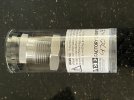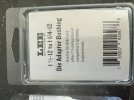On the topic of Crimping, a Lee Crimp die is a special tool that makes the job easier, but with little practice a standard Seating die like RCBS and or Redding can do the same thing effectively. Trick is to go slow very slow infact on the crimping till you find the ideal crimp. Can be done very easily.
On largebore rounds, its very common (and frustrating) to attempt to seat and crimp simultaneously. Barnes TSX are notoriously difficult to get seated and crimped.
A lot of manuals recommend that you seat the bullet as one process, then reset the die without the seating stem and do your crimps. That's fine. Buying a crimp die is even better. Buying a spare seating die to dedicate to crimp alone is a third option.
If the thread shows anything, its that Graeme Wright was error proned. That's not a dig on him, he was the first to write a good book on largebore rifle loading. But he was also inexperienced when he did so. He has corrected a great many errors in his writings in the 3rd edition of his book. I have no desire to crap on the man's work because he had the courage to write it down, but it isn't gospel.
His quote in later editions were that he now crimps because he has hunted in Africa and understands the utility. He goes on to emphasize if you don't crimp, your loads need to be re-regulated once again if you introduce a crimp. You can't fault an author that recants from bad positions, I certainly have had incorrect positions on a myriad of topics and had to correct my theories in light of new data. Hopefully the reader of this thread is able to do the same.

